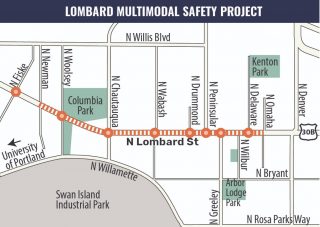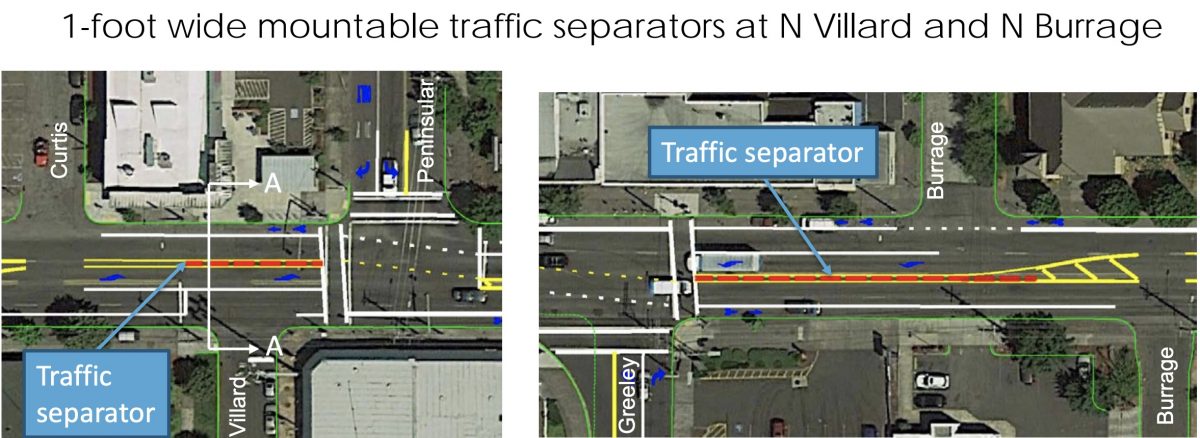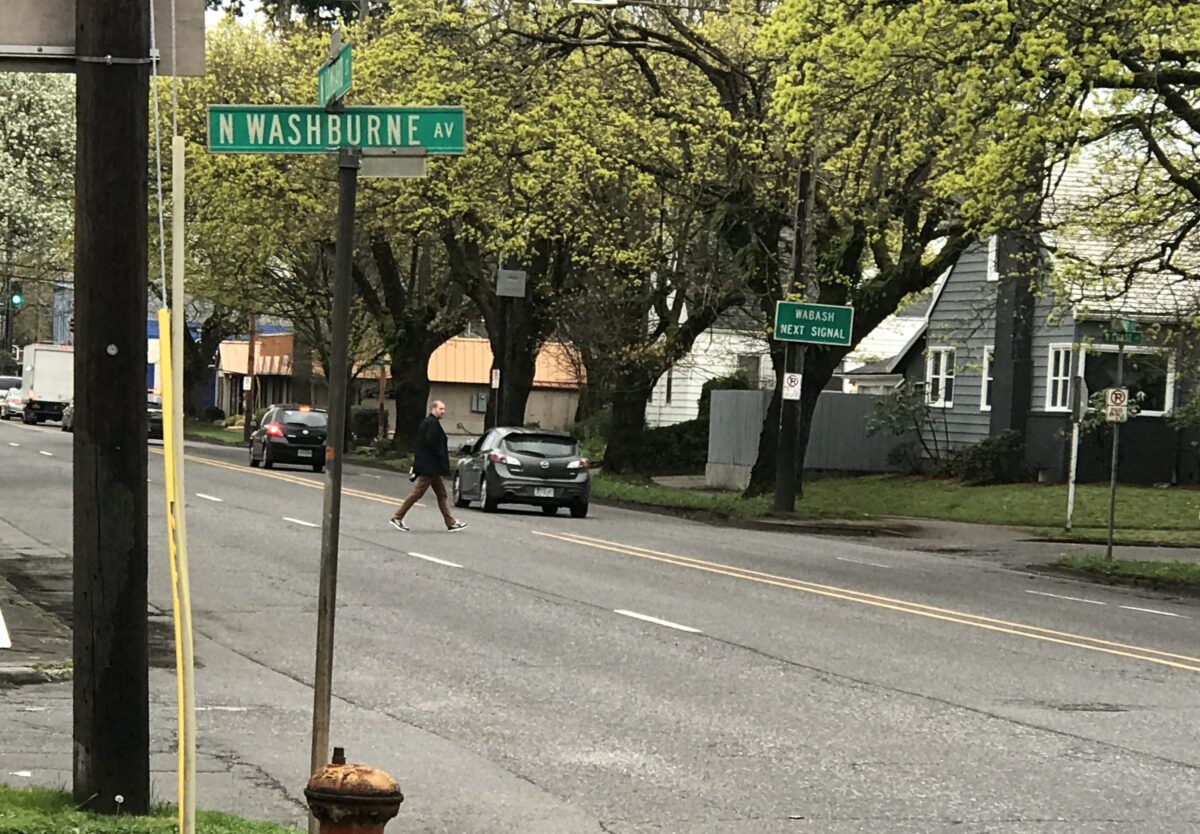
“You’ve got a major freight street here, and again, major freight streets are being turned into multimodal parkways. I don’t understand that.”
— Portland Freight Committee member
I found myself in the rare position of rooting for the Oregon Department of Transportation (ODOT) during the monthly meeting of the Portland Freight Committee on November 7th.
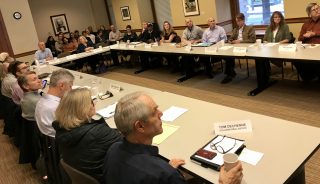
(Photo: J. Maus/BikePortland)
Under fire from a relatively hostile crowd for a project that aims to improve safety through a reduction in driving capacity and new bike lanes on a major freight route, ODOT staffers admirably defended biking and walking.
The PFC, considered to be the most powerful of the City of Portland’s three modal committees (mostly because its members are from major corporations who pay them to attend, unlike the biking and walking committees which are made up of volunteers), heard a presentation on the Lombard Multimodal Safety Project from ODOT staffer Jennifer Bachman.
ODOT’s project will redesign 1.4 miles (25 blocks) of the road between North Fiske and Boston. The PFC was listening closely because — in addition to being an important neighborhood street full of popular stores and restaurants — Lombard also functions as U.S. Route 30 and is a key freight route.
In order to improve safety, ODOT plans to reduce the amount of lanes for driving and add bike lanes in both directions. The current cross-section consists of four multi-purpose lanes and a parking lane. The new cross-section will have three multi-purpose lanes (two for through traffic, one turning) and two bike-only lanes. The project will also add two new crossing treatments with medians and rapid-flashing beacons at Emerald and Burrage (they considered two other crossings at Newman and Washburne but studies showed too few people crossing to warrant the treatment).
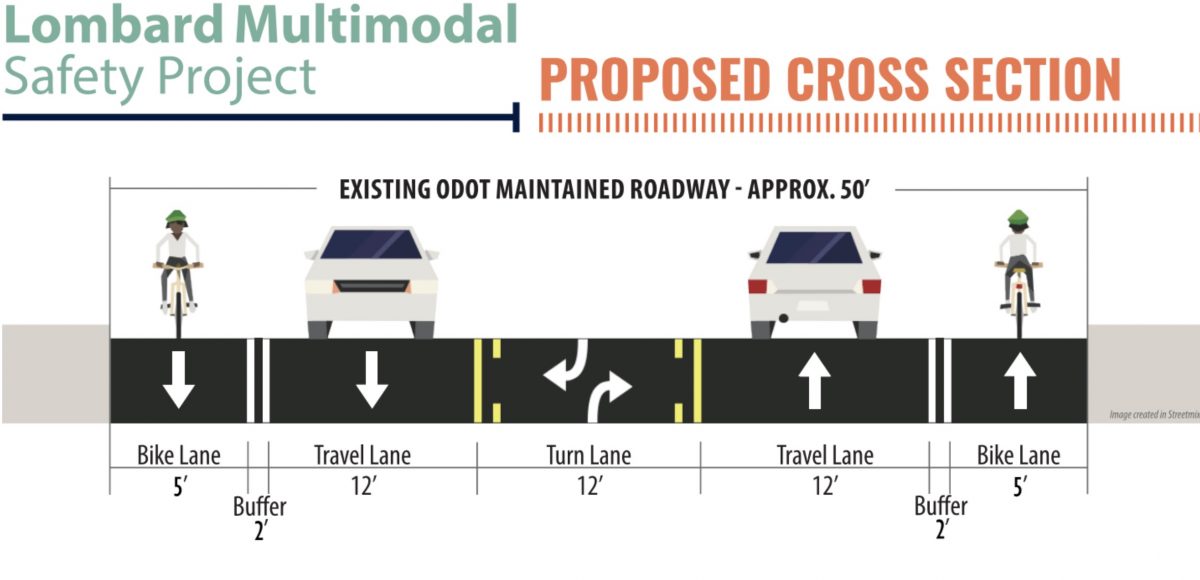
Advertisement
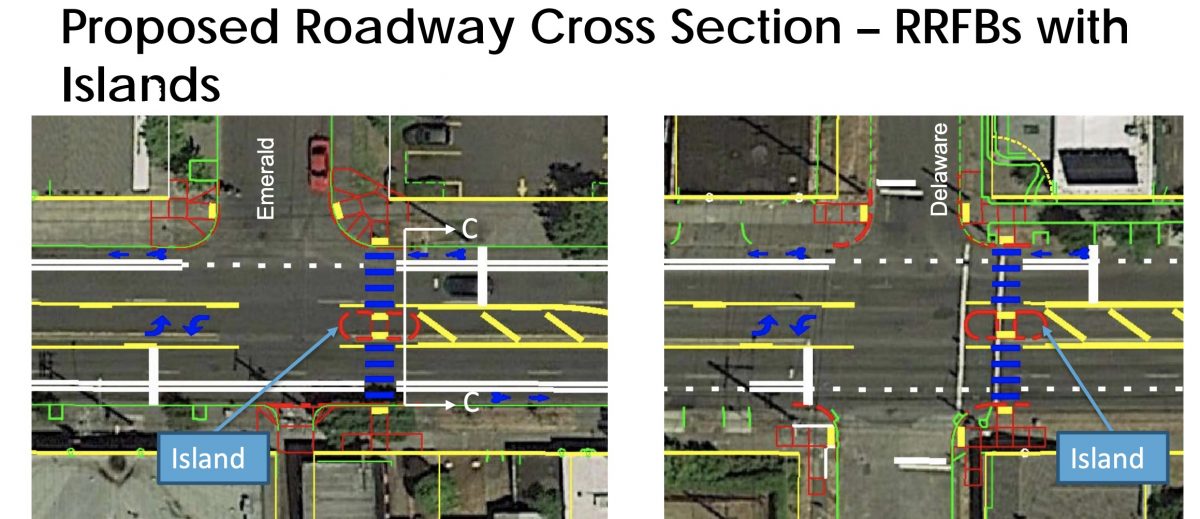
ODOT will also add two sections of mountable traffic separators at Burrage and Villard (see graphic).
According to ODOT’s Safety Priority Index System (SPIS) database, this stretch of Lombard is in the top 1% of all locations statewide. There have been 200 crashes in the past five years and about one crash ever 9-11 days on average — over half of which lead to injuries.
Despite those good intentions, ODOT heard worries that the lane reconfigurations would negatively impact freight hauling.
Oregon Trucking Association President Jana Jarvis expressed concern that the project would reduce freight capacity. “We’re talking about adding bicycle lanes, and sometimes those things conflict,” Jarvis pointed out. The ODOT rep assured Jarvis that the project only re-stripes existing lanes and doesn’t reduce any existing overhead or curb-to-curb width. “We’re not creating any new pinchpoints,” added ODOT trucking expert Tony Coleman. “What you can go through today, you’ll be able to go through after the project is completed.”
But those assurances didn’t seem to be enough for some freight committee members.
“You’re reducing carrying capacity by 50%,” said one distressed committee member (whose name I didn’t get). “That is still a reduction right? You’ve got a major freight street here, and again, major freight streets are being turned into multimodal parkways. I don’t understand that.”
Advertisement
Jarvis also repeated the capacity concern. “But you are reducing a lane,” she said. “Yes,” Bachman replied, “We are reducing through capacity a little bit, but it’s not a 50% reduction like you might think in going from four to two lanes. It’s in the neighborhood of about a 20% reduction in traffic capacity, well within what our model allows.”
“This is a safety project. We are making sure freight isn’t hindered. But this really is a safety project.”
— Jennifer Bachman, ODOT
Rebuffed on the capacity concerns, one member of the committee then asked, “But is [the street] functioning as fast? That matters.”
Committee Chair Pia Welch with FedEx added, “Since we’re a freight group, how is this project improving the movement of goods?”
ODOT’s Coleman challenged the skeptics by reminding them that this project will have the exact cross-section ODOT has already implemented west of Fiske. “Show us the difference it’s made over the years as we’ve put these features in,” he offered to the naysayers. “We feel this project maintains freight capacity and we’re still meeting the needs of pedestrians.”
“This is a safety project,” Bachman added. “We are making sure freight isn’t hindered. But this really is a safety project.”
Another member (didn’t get his name) wondered if bike lanes on freight routes were the new normal for ODOT. “I’m just wondering why we need two bike lanes?” he asked.
Then, in an attempt to remove them altogether, several members expressed skepticism about the bike lanes not having any physical protection. Corky Collier with the Columbia Corridor Association wanted to know if ODOT did any analysis to ensure the lanes would improve safety. “If I’m going to put a bike lane in a relatively dangerous place, maybe I would put that one block over,” he said.
Advertisement
Jarvis added that she feels when bike riders are next to truck operators, there should be more separation. “This seems counter-intuitive,” Jarvis said. “And I agree with Corky, there should have been an analysis of where the most appropriate road was for cyclists, because this is not it.”
Another member said she’s concerned that the removal of the parking lane will take a way a buffer that makes crossing the street safer.
“There should have been an analysis of where the most appropriate road was for cyclists, because this is not it.”
— Jana Jarvis, Oregon Trucking Association
Through all of this, ODOT’s Bachman stood up admirably for the bike lanes and other changes. “This is a multimodal safety project and the movement going forward is to bring in that multimodal aspect — which was something decided at a much higher pay grade than mine. So that’s the project. We’re improving connectivity.” As for the claim that the parking lane made crossing safer? “Clearing out the parking provides better visibility for pedestrians and vehicles can see each other better too,” Bachman said.
The only freight committee member who spoke up for the project was TriMet Senior Planner Jeff Owen. “This striping is helpful for our bus operators because it makes the road more organized,” he said. “From our perspective, this should be a big improvement.”
Committee Chair Welch said the concerns brought up at the meeting were “very good feedback” and she said they need to take a closer look at the design. The PFC plans to draft a letter with their concerns and send it to ODOT.
The project is well into the design phase. Final plans are expected by July 2020 and construction should be completed by 2022.
— Jonathan Maus: (503) 706-8804, @jonathan_maus on Twitter and jonathan@bikeportland.org
— Get our headlines delivered to your inbox.
— Support this independent community media outlet with a one-time contribution or monthly subscription.

